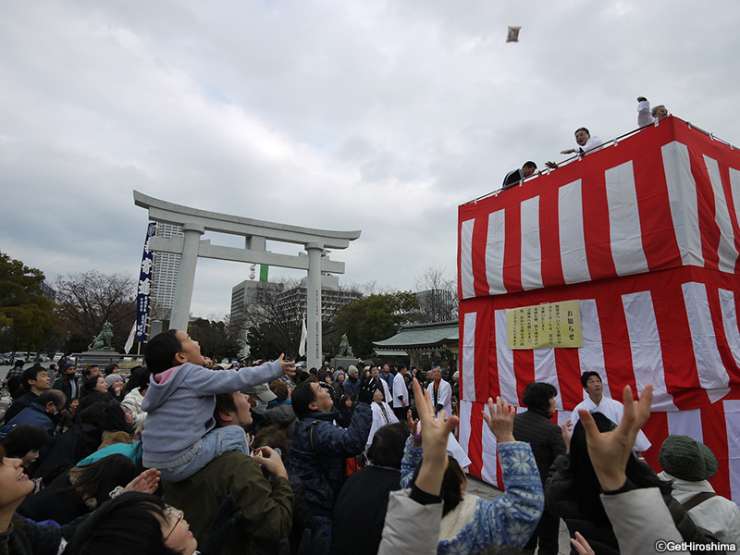

Although the coldest time of the year is often still to come, setsubun marks the shift from winter to spring. Every year on February 3, people all over Japan mark the transition by donning demon masks, scaring little kids, throwing beans, eating giant sushi rolls, spearing stinky fish heads and jumping to grab lucky bags of snacks, all in the name of avoiding misfortune and ensuring good health.
Setsubun rites are carried out at both Buddhist Temples and Shinto Shrines.
In Hiroshima city center setsubun rites are held at Gokoku Shrine located next to Hiroshima Castle, Sumiyoshi Shrine south of Peace Boulevard and at Sorasaya Shrine which both are fairly close to the A-bomb Dome.
At Gokoku Shrine you can view ritual archery conducted by Shinto priests and setsubun at Sumiyoshi Shrine is characterized by the smoking of sardines, the smelly smoke from which is said to stop demons in their tracks. People buy the heads speared with holly sticks to take home and you will likely see them displayed at the entrances to people’s houses in the surrounding streets.


Setsubun rites at Daishoin Temple on Miyajima and Saikoku-ji Temple in Onomichi where local notables throw out beans, snacks and small gifts also attract large crowds.
DIY setsubun kits, complete with demon masks and packs of dried soy beans, can be bought at supermarkets and convenience stores. Draws straws and throw the beans at the demon shouting Oni wa soto, fuku wa uchi! (“Out with the demons and in with the luck!”). For extra good health and fortune, eat as many beans as your age plus one.
The chomping down of long ehomaki sushi rolls in one go while facing the year’s lucky direction might be a Kansai import recently popularized by convenience store chains, but can be fun and makes for a cheap meal.
Setsubun
Date: Setsubun is February 3 every year
Fee: Participation free of charge
Gokoku Shrine
Address: Motomachi 21-2, Naka-ku, Hiroshima-shi, Hiroshima
Website: https://www.h-gokoku.or.jp/ (Japanese website is only available)
Phone: +81-82-221-5590
Information about transport passes:
Visit Hiroshima Tourist Pass
http://www.hiroden.co.jp/en/e-vhtp.html
JR-WEST RAIL PASS
https://www.westjr.co.jp/global/en/ticket/pass/
*Information is correct as of January 2019.
Demons, beans and stinky fish
Address: 21-21-2 Motomachi, Naka-ku, Hiroshima-shi, Hiroshima
Website: https://www.h-gokoku.or.jp/
Phone: 082-221-5590
























































